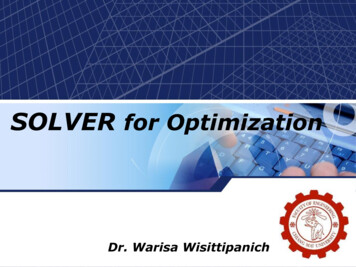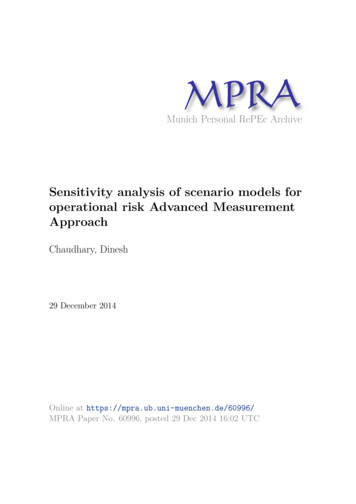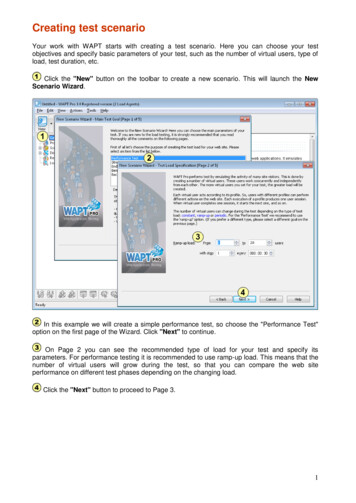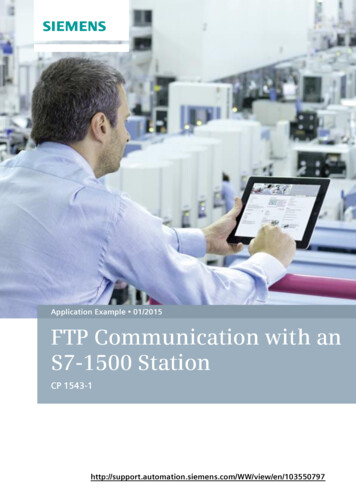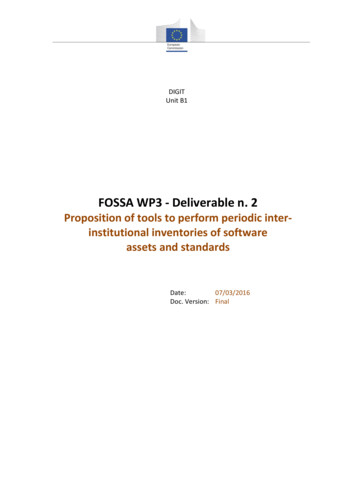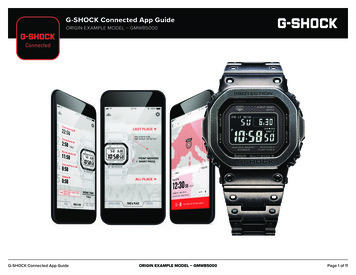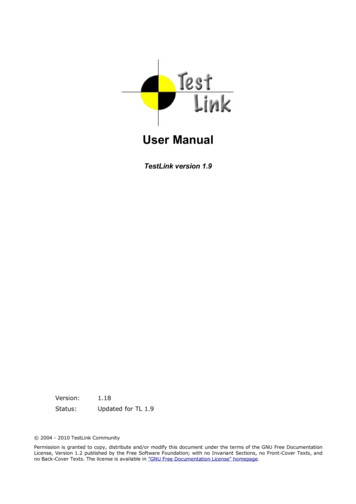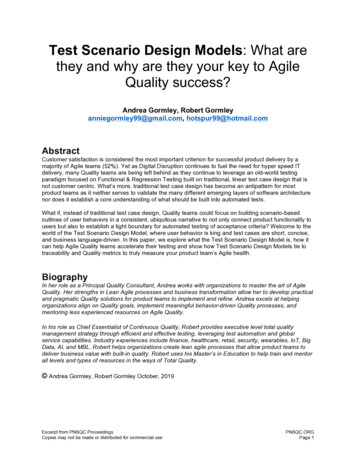
Transcription
Test Scenario Design Models: What arethey and why are they your key to AgileQuality success?Andrea Gormley, Robert Gormleyanniegormley99@gmail.com, hotspur99@hotmail.comAbstractCustomer satisfaction is considered the most important criterion for successful product delivery by amajority of Agile teams (52%). Yet as Digital Disruption continues to fuel the need for hyper speed ITdelivery, many Quality teams are being left behind as they continue to leverage an old-world testingparadigm focused on Functional & Regression Testing built on traditional, linear test case design that isnot customer centric. What’s more, traditional test case design has become an antipattern for mostproduct teams as it neither serves to validate the many different emerging layers of software architecturenor does it establish a core understanding of what should be built into automated tests.What if, instead of traditional test case design, Quality teams could focus on building scenario-basedoutlines of user behaviors in a consistent, ubiquitous narrative to not only connect product functionality tousers but also to establish a tight boundary for automated testing of acceptance criteria? Welcome to theworld of the Test Scenario Design Model, where user behavior is king and test cases are short, concise,and business language-driven. In this paper, we explore what the Test Scenario Design Model is, how itcan help Agile Quality teams accelerate their testing and show how Test Scenario Design Models tie totraceability and Quality metrics to truly measure your product team’s Agile health.BiographyIn her role as a Principal Quality Consultant, Andrea works with organizations to master the art of AgileQuality. Her strengths in Lean Agile processes and business transformation allow her to develop practicaland pragmatic Quality solutions for product teams to implement and refine. Andrea excels at helpingorganizations align on Quality goals, implement meaningful behavior-driven Quality processes, andmentoring less experienced resources on Agile Quality.In his role as Chief Essentialist of Continuous Quality, Robert provides executive level total qualitymanagement strategy through efficient and effective testing, leveraging test automation and globalservice capabilities. Industry experiences include finance, healthcare, retail, security, wearables, IoT, BigData, AI, and MBL. Robert helps organizations create lean agile processes that allow product teams todeliver business value with built-in quality. Robert uses his Master’s in Education to help train and mentorall levels and types of resources in the ways of Total Quality. Andrea Gormley, Robert Gormley October, 2019Excerpt from PNSQC ProceedingsCopies may not be made or distributed for commercial usePNSQC.ORGPage 1
1.IntroductionIn its most recent survey on the State of Agile, VersionOne states that 52% of their respondents believethat success within an Agile initiative is measured by customer/user satisfaction and that success for anAgile project is measured equally by customer/user satisfaction at 46% (VersionOne 2019, 11). Thesepercentages represent a jump for the customer/user satisfaction measurement as previously only 44%and 28% (respectively) of respondents believed this in 2016. Given the raise in the importance ofcustomer/user satisfaction, most savvy IT folks would expect that Quality strategies within Agileorganizations would naturally gravitate toward validating customer/user experience to ensure theirsatisfaction. Surprisingly, in multiple Quality reports at the end of 2018, 75% of respondents suggestedtheir Quality strategies were focused on Functional and Regression Testing. These Quality strategiestypically focus almost entirely on testing at the UI level to ensure proper navigation, functionality, andcompletion of simple rote tasks but do little to address customer/user satisfaction concerns. What’s more,in many of these same organizations focused on Functional and Regression Testing, the key driver fortesting is the over reliance on linear, repetitive test cases that don’t place the customer/user at the centerof the testing effort.How then does an Agile Quality team ensure both built in quality and meet customer needs andsatisfaction? What if, instead of traditional test case design, Quality teams could focus onbuilding scenario-based outlines of user behaviors in a narrative that not only connects productfunctionality to users but also establishes a tight boundary for automated testing of acceptance criteria?We have been employing the use of Test Scenario Design Models, an approach to test case designbased on the work of Cem Kaner’s Scenario-based Exploratory Testing, Hans Buwalda’s Soap OperaTesting, and ISO 25010’s Product Quality and Quality in Use Models, to solve the challenge of placingthe customer/user at the center of the Agile testing paradigm. In doing so, we have been able to helpQuality teams be more successful in achieving both efficiency and effectiveness in Agile testing whileensuring that products being built deliver on the promise of customer/user satisfaction. The use of TestScenario Design Models has allowed our teams to create clear traceability to user stories and acceptancecriteria, the cornerstones of business value delivery for Agile teams.2.What are Test Scenario Design Models?How do you define Test Scenario Design Models? They are scenario-based outlines of user behaviors ina consistent, ubiquitous narrative that allow you to focus on testing at every layer, not just the UI. In thissection, we’ll go through the details of what Test Scenario Design Models are and the history behindthem.2.1 Scenario-based TestingCem Kaner once defined a scenario as “a hypothetical story used to help a person think through acomplex problem or system” (Kaner 2003, 1). Hans Buwalda expanded the scenario definition by sayingthat when used in the context of Soap Opera testing, the scenario is “based on real life, exaggerated, andcondensed” (Buwalda 2004, 31).When we put the two definitionstogether, we have a newdefinition (a workflow) that placesthe user at the center of thetesting effort while emphasizingthe end-to-end nature of thetesting approach. However, if youread carefully into bothdefinitions, the biggest shortcoming in both approaches ishighlighted: the system under test Figure 1: End-to-end nature of scenario-based test designmust be mostly complete, acriterion that most Agile product teams could not meet until the end of a project. Additionally, the problemwith most in-flight Agile Quality efforts is that the original testing strategy typically focuses entirely onExcerpt from PNSQC ProceedingsCopies may not be made or distributed for commercial usePNSQC.ORGPage 2
Functional and Regression testing, an approach that does not look at scenario-based test design andexecution.2.2 ISO 25010’s Product and Quality in Use ModelsIn order to circumvent the shortcomings of the end-to-end testing needing a nearly complete system inorder to test, we’ve brought in ISO 25010’s Product Quality and Quality in Use models. The ProductQuality model of ISO 25010 emphasizestesting at a feature and functional level toassure the static properties of softwareand dynamic properties of the computersystem (ISO 25010, 2011). By focusing onfeatures and functions, the Product Qualitymodel allows testers to focus oncontinuously developed increments ofsoftware during in-flight Sprints. TheQuality in Use model of ISO 25010emphasizes both the context of softwareuse and satisfaction of users to measurethe level of quality maturity in the systemunder test. In Figure 1, you can see howscenario-based tests run horizontally fromone transaction to the next to test acomplete workflow. Whereas in Figure 2,you can see that scenario-based tests tiedinto ISO 25010 run both horizontally and vertically to carve out transactions as discreet modules becauseyou are testing at both feature and functional levels while considering how the modules come together asa whole workflow. Note how, in most cases, user stories and their accompanying acceptance criteria aretypically written in stand-alone fashion like the transactions in Figures 1 and 2. The main point ofcombining scenario-based test design with ISO 25010 is to enable a product team to always be workingtoward a releasable product that delivers end-to-end functionality by always testing for it. A product teamthat delivers code in isolation will always deliver poor quality (lack of integration) and a product team thatdelivers code in end-to-end workflows will likely never deliver code with any sort of speed.Figure 2: End-to-end scenario-based testing with ISO 250102.3 Test Scenario Design Model DetailsAs you can see inFigures 1 and 2, a TestScenario Design Modelfocuses on creatingdiscreet transactions thatcan stand-alone but arepart of a larger workflow.Note that eachtransaction is brokendown into 4 specificparts: the UI/UX, DataManagement,Integration, and Risk.The UI/UX component ofa transaction shouldreflect the behavior ofthe user against theFigure 3: Test Scenario Design Model samplesystem and the response of the system to that behavior. Note, we aren’t talking about the UI exclusivelyas focusing only on the UI simply validates that the system meets requirements but ignores fit for use.Excerpt from PNSQC ProceedingsCopies may not be made or distributed for commercial usePNSQC.ORGPage 3
Data Management is a key component of a Test Scenario Design Model as most modern systems simplystore, manager, or distribute data. As such, making sure that you are validating both system and inherentdata characteristics as well as semantic and syntactical attributes of data is becoming increasinglyimportant. Properly analyzing data requirements allows you to develop the best test data managementstrategy while also identifying the complete data set required to test both your transaction and workflow.Integration points are important to understand as the basis of a Test Scenario Design Model is an end-toend workflow. Ensuring that integrations/hand-offs from one transaction (and in some cases one systemto another) to the next are tested successfully is vital to testing workflows. The areas where defects tendto cluster most in modern systems are at points of integration. Emphasizing this testing is important forimproving your teams defect detection efficiency. The final component of a Test Scenario Design Model isRisk. Because testing exhaustively is impossible (ISQTB, 2011), understanding where risk lies at atransactional level is important for not only understanding where to test but also how much to test.Working in Sprints predicates that QA teams have to be able to follow a more risk-based testing approachin order to meet testing goals but also to ensure team velocity.3.Why use Test Scenario Design Models?Back in the day (you know you’re old when you say that!), we used to proudly talk about the number oftest cases we had written; the larger the number, the better we felt we were doing our jobs. That allchanged when we became part of an Agile product team because Agile favors “working software overcomprehensive documentation (Agile Manifesto, 2001)” and everyone knows having thousands ofmanually written test cases has little value for an Agile product team. There are those who would argue(Robert used to be one of them) that writing detailed test cases helps in automating the test cases.However, we now argue that the increased technical skillset of Quality Engineers means they require lessmundane details (read UI); rather they value a complete story that helps them test the different layers ofsoftware systems. In addition to testing the different layers, automation that leverages Test ScenarioDesign Models focuses on creating modular, stand-alone tests at a transaction level, thus making iteasier to script and much more reusable. The stand-alone, transactional nature of the automated testsallow you to exponentially expand test coverage by simply juxaposing variations of transactions one afterthe other in order to create better coverage of all scenarios. Traditional, linear tests have a limitation inthat they have a singular intent (not parameterized, modular, or mutable) which limits reusability.Test Scenario Design Models are built on fundamental testing principles. We’ve already noted thatexhaustive testing is impossible (Testing Principle 2 according to ISQTB) so explicitly writing out everypermutation of test case is a wasted effort. We also note that testing early (Testing Principle 3 accordingto ISQTB) or shifting left improves testing efficiency and effectiveness while reducing overall cost.Analyzing and planning test strategies for individual user stories while maintaining the focus on the wholepicture allows you to build more comprehensive tests during pre-testing. Capers Jones, in his book TheEconomics of Software Quality, notes that pre-test activities are 25% more likely to find defects comparedto the act of testing itself (Jones 2012, 5). What’s more, we know that testing is context sensitive (TestingPrinciple 6 according to ISQTB), that is to say, the more we know about what we are testing, the betterwe are at finding flaws in the system. Test Scenario Design Models allow you to focus testing at theProduct Quality level but also emphasizes that end-to-end testing should always be the goal to ensurecustomer satisfaction is delivered. Understanding the end-to-end behavior of the customer is truly aligningyour testing to the context of why the system is being built.One final point on why using Test Scenario Design Models is key to Agile Quality success is that they areeasy to create. We like to use the Gherkin language to help us provide a consistent business languagethat is easy to write, read, and maintain. Leveraging Gherkin allows you to both connect your modelsback to the user story and develop fairly detailed traceability to the acceptance criteria. Those teamspracticing Behavior Driven Development can leverage the Gherkin syntax to feed into their Feature Filesof creating automated tests through tools like Cucumber, SpecFlow, and JBehave. We’ve seen howcreating Test Scenario Design Models has reduced test case creation by over 25% or more depending onhow long you’ve used them. In addition to taking less time, we’ve seen a reduction in the number of testswritten by as much as 8 to 1. As more and more organizations embark on the journey to DevOps, Qualityteams are going to be put under considerable pressure to reduce test execution time and parallelizing theExcerpt from PNSQC ProceedingsCopies may not be made or distributed for commercial usePNSQC.ORGPage 4
test execution will only save so much time. It’s going to be up to the Quality teams to achieve a dramaticreduction in the number of test cases in order to support quick deployment times key to DevOps.4.How to Build Test Scenario Design Models?When building Test Scenario Design Models, start by doing the following: List possible users, analyze their interests and objectives List “system events” and understand how the system handles them List “special events” and what accommodations the system should make for them Work beginning to end and break scenarios down into “transactions” tied to UI/UX, data,integrations, and riskIt’s important to note, per Cem Kaner, that your scenario is credible. Kaner writes “it not only couldhappen in the real world; stakeholders would believe something like it probably will happen (Kaner 2003,2)”. Buwalda similarly notes that his Soap Opera tests were written to come up with “stories based on themost extreme examples that had happened, or that could happen in practice (Buwalda 2004, 32)”.Avoiding the “what if” game (when testers sit and think about all the “what ifs”) of test case design is thekey of building the right level detail into the Test Scenario Design Models.4.1 Getting Started with a NarrativeWhen we teach people to create Test Scenario Design Models, we start by getting them to write a shortstory about an experience most people have had before; buying something online at Amazon. We givethem a few simple instructions: Avoid focusing on details like buttons, instead focus on user behavior Identify what event is the starting point and what event is the end point of your story Call out key data pointsHere’s an example of what we see:Merrick received an e-mail from Amazon about the latest iPhone accessory. He was hooked, he had tohave it. He clicked on the link provided and landed on the page for the accessory. He chose his color(red) and initiated the checkout process. Unfortunately, Merrick couldn’t remember his password to log-inso he had to initiate the reset password process. He did that and received an e-mail which gave him histemporary password. He reset it, logged-in, and went to buy his accessory. Before he could check out,Merrick had to add credit card information since he hadn’t saved it the time before. He entered his creditcard info and clicked buy to confirm his order. Apparently, everyone who received the bulk e-mail rushedto buy the accessory and since Merrick had to reset his password, the red-colored accessory was out ofstock!4.2 Breaking It Down to TransactionsOnce we have stories created, we ask our students to break down the stories into discreet transactions.For the example above, here’s how it looks broken down by transaction: Merrick received an e-mail from Amazon about the latest iPhone accessory He clicked on the link provided and landed on the page for the accessory He chose his color (red) and initiated the checkout process Unfortunately, Merrick couldn’t remember his password to log-in so he had to initiate the resetpassword process He did that and received an e-mail which gave him his temporary password He reset his password Logged in Navigated to his accessory He entered his credit card info and clicked buy to confirm his order The accessory was out of stockExcerpt from PNSQC ProceedingsCopies may not be made or distributed for commercial usePNSQC.ORGPage 5
4.3 Using GherkinOnce we’ve broken down the story in to discreet transactions, we ask our students to focus on flushingout the details for each transaction using the Gherkin syntax of Given, When, Then. For the example weare using, the Gherkin would look like this for the first discreet transaction: Given Merrick has received an email from Amazon with a link to an iPhone accessory And he has clicked on the link provided in the email And he has been taken to the Amazon page for the iPhone accessory When he adds the Red accessory to his cart And clicks on the Complete Order button Then Amazon will initiate the checkout process4.4 Layering on UI/UXWith the Gherkin created, we have our students focus on layering the UI/UX underneath it to guidetesters on test execution. Note: the guidance shouldn’t be detailed steps, they should be more focused onproviding identifiers or behaviors to be used to imitate the user. For the example above, here’s what theUI/UX guidance looks like: UI/UX: Email UI/UX: Amazon iPhone accessory page UI/UX: Add to Cart button UI/UX: Complete Order button UI/UX: Login or Proceed as Guest page4.5 Adding the Data LayerThe next step to creating a Test Scenario Design Model is to identify, at a high level, the data required tocomplete a transaction. When you work through the data, it’s important to make sure you consider theinherent (what the data looks like when it is in its raw, newly created form) and systematic (what the datalooks like after it has been handled by a system) nature of the data. It’s also important to includeconsiderations for data syntax (structure) and data semantics (form) as you add the data layer to yourTest Scenario Design Model. If we continue with our previous examples, you would add the data layer inthe following way: Data: Temporary password (syntax & semantics) Data: Username (syntax & semantics) Data: Valid, corresponding password (syntax & semantics) Data: Credit card information (syntax & semantics)When you are identifying the data needed for your Test Scenario Design Model, avoid falling into the “findevery possible combination” trap. The modified condition/decision coverage (MC/DC) testing approachshows that even with testing each entry and exit point, the number of test cases needed for completecode coverage is finite. Here’s an example we use to illustrate this point with our students. We ask ourstudents the following question: if you are testing login functionality with just username and password,how many test cases do you need to test the login functionality completely? Before you (our readers)answer the question, let us give you some of the answers we’ve seen in practice at a number of differentclients. We’ve seen up to 100 test cases used to test login functionality. When we ask why these clientshave so many test cases for validating login functionality, we always hear the same answer; “we makesure we test every combination possible”. When we tell them the correct number of test cases is 4, theydo not believe us and ask us to prove it. Here’s the mathematical proof for why there are only 4 testcases: Test case 1: Username T, Password T, Result Pass Test case 2: Username T, Password F, Result Fail Test case 3: Username F, Password T, Result Fail Test case 4: Username F, Password F, Result FailNote that every combination of “business rule” applied to this proof is simply repeating one of the above 4test criteria. For instance, one case we get all the time is “what if the username has a special character inExcerpt from PNSQC ProceedingsCopies may not be made or distributed for commercial usePNSQC.ORGPage 6
it?” If your username field accepts special characters, it invokes test case criterion #1 and if the usernamefield does not accept special characters, it invokes test case criteria #3 or #4.4.5 Integrations, Integrations, IntegrationsOnce the data layer has been added to the Test Scenario Design Model, add integration areas for yourtransaction. As modern systems have become increasingly complex, the number of integrations withinsoftware systems has dramatically spiked, as has the importance of testing these integrations. When youadd integrations, be sure to focus on sources of data, data locations, services, and security attributes orprotocols. For the example above, the integrations would look like this: Integration: Bulk email Integration: Content manager Integration: Authentication service Integration: Add product to cart service Integration: Credit card validation service Integration: Checkout service fulfillmentIf you find yourself identifying upstream and downstream dependencies, you are on the right track!4.6 Don’t Forget RiskThe final piece of a Test Scenario Design Model is risk. Risk, used here, is focused on prioritizingtransactions based on business value. This definition of risk is sometimes difficult for tester to understandbecause they equate risk to severity or likelihood of failure. When we ask our students what level of Riskthey would attribute to the login transaction, the most common (and by far the most immediate) responseis high. When we ask “why” they gave that response, our students say login functionality is critical for awebsite. When we say that in the Amazon example the Login transaction is low risk, we get a lot ofincredulous looks. We remind our students that Amazon’s core business is to sell something to itscustomers. Whether or not those customers are signed on or not does not make any difference toAmazon because they can complete a purchase as a guest. Therefore, the login transaction does notrepresent a significant risk to Amazon’s business if it does not work. At this point, we remind our studentsabout the importance of context to testing especially as it applies to user-centric design.As you look to assign risk to your transactions, do not lose sight of the fact that integrations should playan important part in determining your risk designation. Transactions that feature in many of your TestScenario Design Models should always have a higher risk designation. If we refer back to the example ofAmazon, the payment transaction would be high not only because the business value is high but alsobecause every business critical scenario for Amazon would leverage that transaction.4.7 Putting It All TogetherIf we put everything together from our previous sections, our Test Scenario Design Model would looksomething like this:Excerpt from PNSQC ProceedingsCopies may not be made or distributed for commercial usePNSQC.ORGPage 7
Note that this Test Scenario Design Model is not complete, we’ve only included three of the transactionsas a sample. The full Test Scenario Design Model is actually 7 transaction. We’ve boxed up thetransactions like a card which can be helpful if you are running Kanban (each box could be a Kanbancard) or if you like using a physical Agile board (treat each box as a testing task to move along the boarduntil it is done) but it’s not necessary to do this.Before we end this section, we want to highlight a few keys points from the Test Scenario Design Modelwe’ve included here as our example. The first point to highlight is how the Given statement forTransaction 2 and Transaction 3 are the Then statements from Transaction 1 and Transaction 2respectively. Note that a link is created between the transactions but that the link is not creating adependency as each transaction could be run independent of the linked transaction. For instance,Transaction 3 can be run at any point in time as long as the user has something in their cart and theyproceed to checkout. You can see that there are also links in other areas of the transaction like in theUI/UX and Integration details but that these links are also independent of each other when it comes totest execution. This point is important because one of the features of Test Scenario Design Models is thatthey are built in a modular way so that you can easily juxtaposition individual transactions in order tocreate more scenarios and expand system coverage quickly.The second point to highlight is the language and syntax used to create each transaction. The Gherkinlanguage gives each transaction description a consistent and easy to follow narrative. That narrativeprovides a tester with a clear test objective and a concise criterion by which they can determine if the TestScenario passes or fails. The syntax is succinct but comprehensive, it gives the tester enough informationto guide their exploration of the system but also provides enough flexibility for the tester to use theiranalytical skills and experience to identify defects.The third point to highlight in this example is that fact that not every transaction has to have details atevery layer. In this example, Transaction 1 and Transaction 3 have no data details because no data isnecessary as an input for the transaction to be completed. Avoid the compulsion to add details to everylayer for the sake of “completing” the transaction details because Test Scenario Design Modelsemphasize the minimal viable product principle.Final, the hardest part of teaching people how to create Test Scenario Design Models is getting them tobreak from the old paradigm of testing that emphasizes quantity over quality. You do not need endlessnumbers of test steps to figure out how to test a system, you simply need high quality guard rails thatkeep you on the right path. We often get pushback here from people who ask “how can you completelytest the system if you don’t explicitly call out what to test in detailed test cases?” It’s a fair questionespecially for organizations that rely heavily on a traditional testing approach where much of the testing isconducted manually. However, according to recent studies like the one done by Dimensional Research,over 87% of QA teams say they have both executive and financial support to implement and use testautomation (Dimensional Research 2018, 2). Test automation is an important factor here because theright strategy around test automation eliminates the need to worry about “completely” testing a system.Take for example a team that is leveraging data models and iteration factories in the test automation theywrite. By virtue of leveraging a data model and iterating data through it, an automated test can literallyexecute hundreds of permutations of data inputs in a single test run. Making use of Test Scenario DesignModels does not mean you move away from good fundamental testing strategies that combine the rightbalance of people, process, and tools. Test Scenario Design Models enable QA teams to focus less timeon meaningless tasks like writing thousands of manual test cases so that they can focus more time onhigh value, user-centric test execution and test automation.5.Test Scenario Design Model MetricsAs we worked to help organizations implement Test Scenario Design Models, one thing has becomeclear to us: traditional “testing” metrics are not going to work as a reporting mechanism. This fact wasmade clear to us when our clients asked us to provide statistics like how many test cases had we createdand how many test cases were being run every day. Since the emphasis of Test Scenario Design Modelswas to reduce the number of test cases being written while increasing the coverage of critical businessExcerpt from PNSQC ProceedingsCopies may not be made or distributed for commercial usePNSQC.ORGPage 8
scenarios, we could not report on simple test case counts. We started to move the reporting conversationaway from numbers of test cases and toward operational readiness by business function. By directing theconversation to readiness, we were able to talk more directly about quality measurements instead oftesting statistics. When we tied in test automation numbers, the product owners became excited aboutt
2.1 Scenario-based Testing Cem Kaner once defined a scenario as "a hypothetical story used to help a person think through a complex problem or system" (Kaner 2003, 1). Hans Buwalda expanded the scenario definition by saying that when used in the context of Soap Opera testing, the scenario is "based on real life, exaggerated, and
